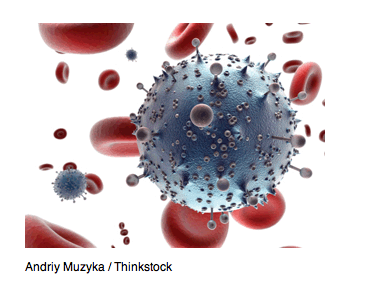| |
HIV treatment [zinc fingers] study clears virus, sends Sangamo stock soaring
|
| |
| |
Mark Ratner
Nature Biotechnology
08 May 2014
HIV eradication-from Berlin to Boston......
http://www.natap.org/2014/HIV/041014_06.htm

Sangamo's SB-728-T therapy uses a zinc finger nuclease to alter CCR5 on T cells, which blocks the HIV virus' entry.
In early March Sangamo Biosciences saw its share price soar after results from the first clinical study of an HIV treatment program using a zinc finger nuclease (ZFN) appeared in the New England Journal of Medicine (NEJM 370, 901-910, 2014 - Gene Editing of CCR5 in Autologous CD4 T Cells of Persons Infected with HIV (Zinc fingers) - http://www.natap.org/2014/HIV/041014_05.htm).
The study showed that infusing HIV-infected individuals with their own CD4 T cells, in which the CCR5 gene had been altered ex vivo using the ZFN method, was safe-in one patient, the treatment drove viral load down to undetectable levels. CCR5 was targeted because it encodes a co-receptor required for the virus to penetrate the cell, and individuals with a natural CCR5 mutation are known to resist HIV infection. Sangamo, located in Richmond, California, designed a ZFN pair of proteins, which, by binding CCR5, induce an acquired genetic resistance to HIV (Nat. Biotechnol. 26, 808-816, 2008 - New Gene Therapy Disrupts CCR5/HIV Entry: Establishment of HIV-1 resistance in CD4+ T cells by genome editing using zinc-finger nucleases- http://www.natap.org/2009/HIV/020409_02.htm).
All participants in the phase 1 study were on antiretroviral therapy (ART) while receiving the cells with altered CCR5, called SB-728-T; four weeks later, half had their ART therapy interrupted for 12 weeks to test the effect of the SB-728-T infusion. The NEJM study demonstrates that the modified cells can be safely administered back to the individual; are able to persist and circulate throughout the body to key reservoirs of HIV infection; and survive longer than unmodified cells when antiviral drugs are withdrawn, potentially keeping the virus under control without the use of drugs, says senior author Carl June of the University of Pennsylvania in Philadelphia. The person with undetectable viral load after receiving the cell infusion was later found to have already been carrying a natural mutation of CCR5 (CCR5 delta-32) in one allele.
Sangamo's results reinforce the belief that an immunological approach could control HIV infection and eliminate the need for lifelong antiretroviral therapy, he says. In a second study, a phase 1/2 trial reported at the Conference on Retroviruses and Opportunistic Infections in Boston on March 6, preconditioning patients with the chemotherapy cyclophosphamide prior to a single infusion of SB-728-T led to a dose-dependent increase in the engraftment of modified cells and total CD4 cell counts. [CROI/2014: Cyclophosphamide Enhances SB-728-T (zinc fingers) - http://www.natap.org/2014/HIV/041014_04.htm]
Engraftment to Levels Associated with HIV-RNA Control
In commenting on the potential impact of Sangamo's work on Gilead Sciences, the Foster City, California-based maker of antiretroviral therapies, analyst Michael Yee of RBC Capital Markets in San Francisco noted that it's not clear which subgroup of HIV patients would benefit from SB-28-T therapy. The subgroup of heterozygous CCR5 delta-32 patients "might be only 5-10% of HIV patients," he said. Further, an accompanying editorial in NEJM cautioned that consistently blocking both alleles for CCR5 using this technology is "not yet tenable" and that the off-target risks are as yet unknown. Nonetheless, Sangamo's stock gained more than 17% the day after the news broke, rising to $22.96 per share, helping pave the way for the pricing of a follow-on stock offering later in March at $22.50, which would add almost $94 million to its coffers. Sangamo has said that with positive data from its phase 2 clinical trials of SB-28-T, it would seek a partner for further development and commercialization. Earlier this year it licensed ZFN technology to Cambridge, Massachusetts-based Biogen Idec for development of therapies for the hemoglobinopathies sickle-cell disease and beta-thalassemia.
|
|
| |
| |
|
|
|